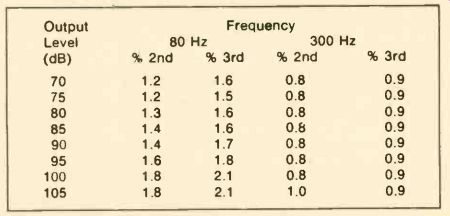
A Moderately Priced Bookshelf Speaker from RTR
The Equipment:
RTR EXP-12, a full-range speaker system in wood enclosure.
Dimensions: 25 1/2 by 14 1/4 inches (front); 11 1/2 inches deep.
Price: $139.
Warranty: three years parts and labor; shipping paid one way.
Manufacturer: RTR Industries, Inc., 8116 Deering Ave., Canoga Park, Calif. 91304.
Comment: The RTR EXP-12 is a recent entry in the "middle price" range of air-suspension speaker systems.
It uses a 12-inch woofer and a 4-inch tweeter. (RTR also offers an 8-inch version, the EXP-8 at $89.) The unit is fairly conventional in appearance, but a novel feature is the inclusion of a circuit breaker at the rear as a safety de vice against possible overload. The rear also contains the connections (red and black colored binding posts) and a continuously variable tweeter level control. The EXP-12 may be positioned horizontally or vertically.
Rated for 8 ohms impedance, the EXP-12's measured nominal impedance (just above the bass rise) is 7 ohms.
Above the rating point the impedance increases gradually across the band. Efficiency is moderately low, though not as low as in some air-suspension systems. The EXP-12 needs 3 watts of input to produce the standard output test level of 94 dB (at 1 meter on axis). It can handle steady state power to 32 watts, for an output of 105 dB, before distorting excessively. The circuit breaker trips short of 100 watts in this test. With pulsed input the speaker handles up to 193 watts (average), to produce an output of 116 dB, before excessive distortion. The data here, in sum, indicates good dynamic range. The manufacturer recommends driving the unit with amplifiers or receivers rated for 20 to 80 watts per channel, and the lab measurements confirm this as an appropriate rating.
The measured frequency response--for which CBS Labs sets any controls at their mid-position when, as here, no specific recommendation is supplied with the product--shows a gradually rolled off high end that can be brought up somewhat (about 5 dB in on-axis measurements) by rotating the rear balance control to its maximum (number 10) position. This control's effect starts with a 1-dB difference (between minimum and maximum rotation) at about 1,000 Hz and increases up the scale, with maximum effect (8 dB) between 6,000 and 10,000 Hz. There are approximately 5-dB differences from 3 to 5.5 kHz and from 11 to 20 kHz. An instruction sheet furnished with other samples of the speaker, however, recommends leaving this control at or near the maximum (10) position for average listening conditions, and we agree. In this position the EXP-12 "listens" far better than the curves look.
The output generally is well dispersed. At about 4 kHz a moderate amount of directivity becomes evident, but it doesn't increase significantly as you move up the scale. A 10-kHz tone is clearly audible well off axis of the system; so is a 12-kHz tone, but within a narrower angle. Tones above 12 kHz are audible primarily on axis, with an apparent dip to inaudibility beginning at about 14.5 kHz.
At the low end of the response band, doubling begins at about 50 Hz and continues increasingly as frequency is lowered. Deep bass response is, of course, affected by speaker placement. With the unit on a shelf and near a corner, we judged it clean and firm (above average perhaps, for the price class); with floor placement, some listeners found it on the weak side and output below about 40 Hz to be mostly doubling.

---------RESPONSE CHARACTERISTICS (1 watt input)

----------RTR EXP-12 Harmonic Distortion

---- Distortion data are
taken on all tested speakers until distortion exceeds the 0% level
or the speaker produces the spurious output known as buzzing, whichever
occurs first.
The RTR EXP-12 precipitated sharply divergent opinions in our listening panel. Some listeners found the treble entirely adequate; others felt that it could use a little more brightness even in the maximum position. The latter group tended to complain of some "boxiness," while others commented on the sneaker's freedom from boxiness. A/ B comparisons between the EXP-12 and another (three-way) system at a somewhat higher price seemed especially revealing. One listener in particular found the EXP-12 wanting in highs by comparison but commented that he believed it to be the "more musical" and the one he would prefer to "live with." The explanation seems to lie in its freedom from midrange coloration--which, subjectively, makes the sound seem to have "less highs"--and from midrange ("presence") emphasis.
Obviously we can't tell, on the basis of our tests, how good a value individual listeners will deem the EXP-12 to represent: It can vary from excellent to fair with your sonic tastes. We do, emphatically, recommend that you listen to it.
-------------
(High Fidelity, Jul. 1975)
Also see:
Stanton Model 881S phono cartridge (Equip. Report, Nov. 1977)
Sony Model TAN-8550 power amplifier